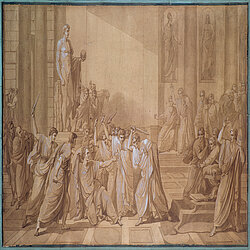Loading the page ...
Vincenzo Camuccini
1771–1844, Rome
Vincenzo Camuccini’s career usefully exemplifies what is often the fragile and short-lived nature of fame. In Rome at the beginning of the nineteenth century Camuccini was considered one of the most important and influential artists of the day with a reputation that could only be compared to that of Antonio Canova. By the end of the same century, however, he had already fallen into complete oblivion.
Camuccini received his earliest education as a painter under Domenico Corvi in Rome, but he was essentially an autodidact, who studied the work of Raphael and Michelangelo with particular intensity, and was drawn to antiquity by the writings of Winckelmann. In the 1790s Camuccini belonged to an artists’ brotherhood with the beautiful, though somewhat pretentious name of the Accademia de’Pensieri, where he associated with such like-minded artists as Luigi Sabatelli, Giuseppe Bossi, and Pietro Benvenuti. In 1798 the upheavals of the Roman Revolution persuaded Camuccini to leave the city for a short period, but a few years later his reputation was already on the rise there. With the death of important predecessors like Anton Raphael Mengs and Pompeo Batoni, an artistic vacuum opened in Rome. Camuccini cleverly used this moment to introduce a new stylistic language indebted to French Neoclassicism in the manner of Jacques-Louis David. In 1802 he became a member of the Accademia di S. Luca and he was already its president by 1805. Due to his official position, Camuccini’s Neoclassical ideal became the determining influence on Roman artistic life after 1800. The French reign in Italy was another factor that served Camuccini well. In 1810 the artist traveled to Munich and Paris where he was received by Napoleon and where he later met David. Camuccini’s close contacts with the French occupiers clearly did not harm his position in the Vatican, since in 1803 he was named director of the papal mosaic manufactory by Pope Pius VII. In 1809 Camuccini was appointed director of the Vatican paintings collection and in 1814 he became inspector of fine arts, an extremely influential position that he retained until 1843.
Archive
